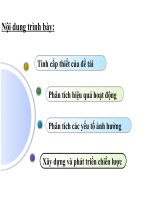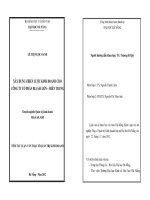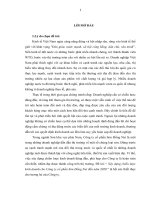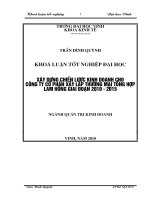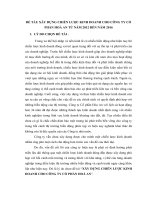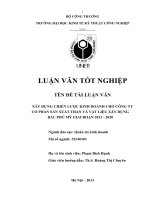Xây dựng chiến lược kinh doanh cho công ty cổ phần thương mại vận tải sông đà
Bạn đang xem bản rút gọn của tài liệu. Xem và tải ngay bản đầy đủ của tài liệu tại đây (722.16 KB, 68 trang )
LUẬN VĂN THẠC SĨ
Xây dựng chiến lược kinh doanh cho công ty cổ phần thương mại
vận tải Sông Đà
THESIS MBA
FORMULATING BUSINESS STRATEGY
FOR SONG DA TRADING AND
TRANSPORT JOINT STOCK COMPANY
FROM 2015 TO 2020
TABLE OF CONTENTS
1
TABLE OF CONTENTS
ACKNOWLEDGEMENT......................................................................................4
ABBREVIATION....................................................................................................5
LIST OF FIGURES.................................................................................................6
LIST OF TABLES...................................................................................................7
LIST OF APPENDIX..............................................................................................8
EXECUTIVE SUMMARY.....................................................................................9
INTRODUCTION.................................................................................................11
CHAPTER 1: THEORICAL FRAMEWORK....................................................15
1.1.
Definitions:...................................................................................................15
1.1.1.
Strategy definition:...............................................................................15
1.1.2.
Vision statement:..................................................................................15
1.1.3.
Mission statement................................................................................16
1.1.4.
Strategic objectives..............................................................................16
1.2.
Strategic levels:............................................................................................17
1.2.1.
Corporate - level strategy:....................................................................17
1.2.2.
Business - level strategy:.....................................................................18
1.2.3.
Functional - level strategy:..................................................................18
1.2.4.
Operation strategy:...............................................................................18
1.3.
Business strategies:......................................................................................20
1.3.1.
Cost leadership strategies:...................................................................20
1.3.2.
Differentiation strategies:....................................................................20
1.3.3.
Focus strategies:...................................................................................20
1.4.
Formulating strategy and business strategy:...............................................21
1.4.1.
Formulating model:..............................................................................21
1.4.2.
External environment audit model......................................................22
1.4.3.
Internal environment audit model........................................................28
1.4.4.
Strategic choices..................................................................................31
2
1.4.5.
Strategic implementation:....................................................................33
CHAPTER 2: STRATEGIC ANALYSIS FOR SOTRACO..............................35
2.1.
Introducing the SOTRACO’s background..................................................35
2.2.
Actual performance of SOTRACO 2007-2009...........................................36
2.3.
Strategic analysis.........................................................................................38
2.3.1.
PEST analysis:.....................................................................................38
2.3.2.
Five Forces analysis:............................................................................42
2.3.3.
Internal analysis...................................................................................47
2.4.
Current business strategies..........................................................................52
2.4.1.
Diversification at corporate level.........................................................52
2.4.2.
Low cost provider at business level.....................................................53
CHAPTER 3: SUGGESTED SOLUTIONS TO IMPLEMENT STRATEGIES
FOR SOTRACO 2010- 2015.................................................................................54
3.1.
Development orientation.............................................................................54
3.1.1.
SWOT analysis....................................................................................54
3.1.2.
Mission,vision and objectives..............................................................55
3.2.
Suggested strategies.....................................................................................56
3.2.1.
Continue pursuing diversification strategy at corporate level.............56
3.2.2.
Pursuing differentiation strategy.........................................................57
3.3.
Strategic implementation...................................................................................60
3.3.1.
Road map for strategy implementation...............................................61
3.3.2.
Controlling and evaluating strategy implementation............................62
CONCLUSION......................................................................................................63
REFERRENCES...................................................................................................64
APPENDIX............................................................................................................75
3
ACKNOWLEDGEMENT
This is a valuable chance for us to have an insight into method of forming strategy
for one company. This is also scare opportunity for us to apply knowledge and
basic skills which we have learnt from MBA program to solve a practical problem
of a company.
We would like to thanks all teachers and lecturers in the Griggs University who
spent so much time ands efforts to instruct us to complete the project and the MBA
course.
And we would like to extend my special thanks to SOTRACO’s management board,
for facilitating our MBA pursuit both in encouragement and working supports. We
are also grateful to our friends, the staffs and managers of SOTRACO for their help
during the time of data collection and interview for this project.
Finally, we would like to take this opportunity to thank our family, especially for
their constant support and encouragement so that we can complete this course
successfully.
4
ABBREVIATION
WTO
World Trade Organization
APEC
Asia –Pacific Economic Co-operation
ASEM
Asia – Europe Meeting
SBU
Strategic Business Unit
PEST
Political, Economic, Society, Technology.
SWOT
Strength, Weakness, Opportunity, Threat
IT
Information System
R&D
Research & Development
SOTRACO:
Song Da Trading and Transport Joint Stock Company
RBV
Resource-Base View
VCA
Value Chain Analyze
EFE
External factors evaluation
5
LIST OF FIGURES
Figure 1.1: The strategy-Making hierarchy...........................................................19
Figure 1.2: Comparison of strategic choices.........................................................21
Figure 1.3: Formulating business strategy model..................................................22
Figure 1.4: A company’s external environment....................................................23
Figure 1.5: The five forces model of competition..................................................26
Figure 1.6: The value chain activities....................................................................30
Figure 1.7: The SWOT matrix................................................................................32
Figure 1.8: The Strategic Balanced Scorecard Framework...................................34
Figure 2.1: VND/USD exchange rate history........................................................41
Figure 2.2: IE matrix ............................................................................................51
Figure 2.3: Comparative position of transportation industry................................52
Figure 3.1: Business structure of SOTRACO 2015................................................56
6
LIST OF TABLES
Table 2.1. Comparative statistics of competitors of construction and building area
(2008)..................................................................................................................... 36
Table 2.2. Some comparative financial figures of SOTRACO 2007-2009..............37
Table 2.3: Actual financial status in the years 2007-2009.....................................37
Table 2.4 – Financial coefficients of the company 2008........................................38
Table 2.5 EFE matrix of SOTRACO......................................................................47
Table 2.6: IFE matrix of SOTRACO......................................................................50
Table 3.1: SWOT analysis of SOTRACO...............................................................54
Table 3.2.Road map for strategic implementation.................................................61
7
LIST OF APPENDIX
Appendix 1: The balance sheet of SOTRACO 2008
EXECUTIVE SUMMARY
8
Established in 2003 as one subsidiary of Song Da Corporation, one of the big and
reputable companies operating in Vietnam, SOTRACO would take advantages of a
good foundation from its mother to develop. After over 6 years of operation, it has
accomplished quite a lot achievement during its operation period, however, still
bears some mistakes to be improved.
Like any other companies, SOTRACO is impacted by various factors including both
external and internal ones. Briefly, SOTRACO should enjoy stable politics of
Vietnam with almost no threat of war in accordance with looser policies of the
Vietnamese Government in the efforts of attracting FDI and ODA from foreign
investment. In addition, a sustainment and increasing economy also creates
favorable condition for SOTRACO to operate in. This enables company to take
part in more projects and have chances to upgrade its technologies and enhance its
management and production skills. Nevertheless, an open economy of Vietnam also
indicates fierce competition from not only domestic companies but also different
competitors and potential rivals from other countries. In addition, a lot threats
come from external environment such as high inflation rate, increasing fast of
material price, the substitution of product, etc. To some extent, these rivals would
outcompete SOTRACO in terms of both price and quality of products if it does not
know how to promote and improve itself.
Regard to internal factors, reputation of Song Da corporation brand name is
considered valuable intangible asset. SOTRACO was listed in the stock exchange of
Vietnam, therefore, it can be easier for the company to raise capital but in fact, this
capital source has been utilized. In addition, although SOTRACO has good basis in
some production areas such as transportation of goods, this is cooperated with the
fact that SOTRACO has limited management and working skills due to the
characteristics of a company originated-state-owned model. Moreover, SOTRACO
diversified its business in various areas, which makes SOTRACO
encounter
difficulties in finding appropriate solutions to help the company exploit
9
opportunities better and overcome challenges to continue the sustainable
development.
Base on SWOT model which match external – internal environment, diversification
is suggested for corporate level strategy. It helps company improve competitive
ability by the way to develop strengths, limit weaknesses, exploit well opportunities
and overcome threats. In business strategy level, differentiation strategy is
recommended so that SOTRACO can focus its resources and capabilities in specific
areas in order to increase its competitiveness over its rivals. In the last part, the
group has proposed some main solutions to implement strategies with the hope that
these solutions can be applied to the reality and become useful.
INTRODUCTION
10
1. Rationale:
In the past, the economy of Vietnam was still closed and there was almost no trade
agreement between Vietnam and other countries. However, since 1986, Vietnam
opened its economy and this year became one special milestone for the economy of
Vietnam. Opening the economy, joining in various economic parties or organization
brings Vietnamese enterprises more golden opportunities to develop but also
indicates a large number of challenges and threats coming from outside our nation.
Note that in some recent years, like many other countries in the world, Vietnam’s
economy has been seriously affected by globalization trend in almost every
business area.
In such kind of volatile environment, crafting and executing strategy are top-priority
managerial tasks for two very big reasons. First, a clear and reasoned strategy is
management’s prescription for doing business, its road map to competitive
advantage, its game plan for pleasing customers and improving financial
performance. Second, a strategy-focused enterprise is more likely to be a strong
bottom-line performer than a company whose management views strategy as
secondary and puts its priority elsewhere. In other words, there’s no escaping the
fact that the quality of managerial strategy making and strategy execution has a
highly positive impact on revenue growth, earnings and return on investment [2].
Established as a subsidiary of reputable Song Da Corporation, Song Da Trading and
Transport Joint Stock Company (SOTRACO) enjoyed a good basis to grow in some
“traditional” areas of Song Da Corporation, then promoting diversification in other
industries. SOTRACO is chosen as an example of an enterprise that has been
influenced by various external factors of social, economic, political, technological,
etc ones but is quite successful thanks to putting priority in crafting and executing a
good strategy. This project is conducted under the title “Forming business strategy
for Song Da Trading and Transport Joint Stock Company 2010-2015” aims at
analyzing how this company kept itself growing in such kinds of business
11
environment and recommend some solutions to implement its strategies in next 5year period.
2. Research objectives
This research, including analysis of both external and internal factors affecting the
business, is conducted as a tool for students to systemize and apply strategic
management’s theory in reality. In addition, it can be used to support STRACO in
getting thorough understanding of its strengths and weaknesses together with
opportunities and threats, then, generating a long-term vision and formulating
business strategies which are able to fit well with the business model and the real
current conditions of the company in a volatile business environment from 2010 to
2015. To some extent, it also can be recommended as material for some other
enterprises sharing the similar conditions and resources as STRACO.
3. Scope of research
Established under the umbrella of Song Da Corporation, STRACO would take
advantages of this strong basis to boost itself in many business areas such as
building and construction, transportation, production of material and accessories for
building and construction industry, directly involvement in construction of building
and development of infrastructure and factories, etc.
However, due to time and human resources as well as understanding limitations, the
focus of this research is on the time frame of 5 years and some key operation areas
of the company inside Vietnam’ border.
4. Research methodology:
4.1. Collecting data:
4.1.1. Secondary Data:
Secondary data is employed as the main research methodology of this research.
This type of data was collected mainly from the company’s reports, collected from
newspaper, internet, magazine, etc. Since this company was listed in the stock
exchange of Vietnam, therefore, information (especially internal information such
12
as profile, finance situation, business plan, etc) was rather available and easy to be
collected on mass communications.
4.1.2. Primary data:
Apart from secondary data, primary data which is collected by the researchers is
exploited. Some lists of questions were delivered to SOTRACO’s leaders,
managers, employees, customers to gather sufficient information and data needed
for the report. The questionnaire was firstly designed, delivered to some above
types of participants, collected, processed and then analyzed as a very useful
analyzing tool.
5. Structure of capstone project report:
Apart from the acknowledgement, table content, executive summary, introduction,
conclusion, references, and appendices, the main body of this capstone project
report is divided into three chapters as following:
Chapter 1: Theoretical framework
This opening chapter is taken as summary of relevant theories which are used to
analyze environment and formulate strategies for STRACO
Chapter 2: Strategic analysis for STRACO
This chapter illustrated applications of some theories summarized in the previous
chapter to the real case of STRACO. Therefore, it would give deeper understanding
about STRACO’strategic choices. Especially in this part, we focus on application of
some well-known strategic tools such as SWOT analysis or value chain analysis
model into this company.
Chapter 3: Suggested solutions to implement strategies for SOTRACO 20102015
In this final chapter, strategies for corporate level and business level which meet to
business environment in new period are suggested. In addition, proposing some
main solutions to implement strategies for STRACO in the period of 2010-2015.
13
CHAPTER 1: THEORICAL FRAMEWORK
1.1.
Definitions
14
1.1.1. Strategy definition:
Perhaps, there are various definitions of the word “strategy” developed by
strategists. This paper would provide you one of them in simple words.
A
company’s strategy is management’s action plan for running the business and
conducting operations. The crafting of a strategy represents a managerial
commitment to pursue a particular set of actions in growing business, attracting and
pleasing customers, competing successfully, conducting operations, and improving
the company’s financial and market performance. Thus a company’s strategy is all
about how-how management intends to grow the business, how it will build a loyal
clientele and outcompete rivals, how each functional piece of the business will be
operated, how performance will be boosted [2]. In their book “Crafting and
executing strategy-the quest for competitive advantage, concepts and cases”
(2007), Thompson, Strickland and Gamble suggests “An organization’s strategy
deal with how to make management’s strategic vision for the company a reality – It
represents the game plan for moving the company into an attractive business
position and building a sustainable competitive advantage” [2, pp.256].
1.1.2. Vision statement:
Vision statement of an organization aims at answering the question “What do we
want to become?”. It is especially important for any managers to set up long term
objectives and executives to achieve good performance. A clear vision provides the
foundation for set up strategy and all organization’s operations follow it.
Developing a vision statement is first step in strategic planning. Many vision
statements are single sentences only. It may also contain a slogan, diagram, or
picture – whatever grabs attention [2]. For instance, the vision of eBay is “Provide a
global training platform where practically anyone can trade practically anything” [8,
pp. 115].
1.1.3. Mission statement
15
The defining characteristic of a well-conceived strategic vision is what it says about
the company’s future strategic course “The direction we are headed and what our
future product/market/customer/technology focus will be”
In contrast, the mission statement that one finds in the company annual reports or
posted on company Web sites typically provide a brief overview of the company’s
present business purpose and raison d’être, and sometimes its geographic coverage
or standing as a market leader. They may or may not single out the company’s
present products/services, the buyer needs it is seeking to satisfy, the customer
groups it serves, or its technological and business and capabilities. But rarely do
company statements say anything about where the company is headed, the
anticipated changes in its business, or its inspirations, hence, they lack the essential
forward looking quality of a strategic vision in specifying a company’s direction
and future product/market/customer/technology focus [2].
1.1.4. Strategic objectives
Strategic objectives are used to concretize the mission statement. They show that
how the organization can fulfill or move toward the mission and vision. The
organization’s objectives should be whether financial or non-financial, but it needs
to meet these basic following criteria
• Measurable: There must be at least one indicator that measure progress
against fulfilling the objective.
• Specific: This provides a clear massage as to what need to be
accomplished
• Appropriate: It must be consistent with the vision and mission of
organization.
• Realistic: It must be achievable target given the organization’s
capabilities and opportunities in the environment. In essence, it must be
challenging but doable.
16
• Timely: There needs to be a time frame for finishing the objectives [7].
1.2.
Strategic levels:
In order to give suitable strategies and especially is assign responsibility for
manager levels, in diversified enterprises, strategies are initiated as four distinct
organization levels. There’s a strategy for the company and all of its business as a
whole (corporate strategy). There’s a strategy for each separate business the
company has diversified in to (business strategy). Then there is a strategy for each
specific functional unit within a business (functional strategy). Each business
usually has a production strategy, a marketing strategy, finance strategy, and son on.
And, finally, there are still narrower strategy for basic operating unit-plants, sale
districts and regions, and departments with thin functional areas (operating
strategy).
1.2.1. Corporate-level
“Corporate strategy concerns how a diversified company intends to establish
business position in different industries and the actions and approaches employed to
improve performance of the group of businesses the company has diversified into”
[2, pp. 56]. Normally, in this strategy level, company has three major strategies to
choose that are firstly focus on a single business. The company focuses all of its
resource such as finance, human resource, brand, and so on to compete successfully
in a single business which the company has chosen. Second, vertical integration
represents an expansion or extension of the firm by integrating preceding or
successive productive processes. That is, the firm incorporates more processes
toward the original source of material (backward integration) or toward the ultimate
consumer (forward integration). Third, diversify business operation into other
businesses which have related or unrelated with its current business. Generally, all
of diversified strategies aim to increase value objectives by many ways such as
using each other’s competitive advantages to decrease cost and improve benefit or
improve competitive ability comparing with competitors. There are many ways to
17
implement diversified strategy such as merger and acquisition (M&A), joint
venture/strategic alliances, internal development [2]
1.2.2. Business-level
Thompson and Strickland define: “Business strategy concerns the actions and the
approaches crafted by management to produce successful performance in one
specific line of business; the central business strategy issue is how to build a
stronger long-term competitive position” [2, pp. 245].
In other words, business strategy refers to the managerial game plan for a single
business, showing the way to achieve successful performance in one specific line of
business.
All strategy levels are not independent with each other. Formulating strategies is
process from top to down. Different management levels are in charge of managing
different strategy levels. Corporate strategy is responsibility of corporate-level
managers, business strategy is responsibility of business level-general managers,
functional strategy is responsibility of heads of major functional activities within a
business unit or division and operating strategy is responsibility of plant managers,
geographic unit managers, and managers of front line operating units.
1.2.3. Functional - level
The functional strategy concerns the managerial game plan for running a major
functional activity or process within a business-R&D, production, marketing,
customer service, distribution, finance, human resource, and so on; a business needs
as many functional strategies as it has major activities [2].
1.2.4. Operation-level
The operation strategy illustrates how to manage front line organizational unit
within a business (plant, sale, district, distribution center) and how to perform
strategically significant operating task (material purchasing, inventory control,
18
maintenance shipping, advertising campaigns) [2].Figure 1.1 below shows the
strategy–making hierarchy for diversified company.
Figure 1.1: The strategy-Making hierarch [2,pp.39].
1.3.
Business strategies:
19
One organization can take into account different external and internal factors to
choose which generic competitive strategies to employ: low cost provider strategies,
differentiation strategies, focus (market niche). Each strategic choice bears its own
strengths and shortcomings.
1.3.1. Cost leadership strategies:
Cost leadership focuses on providing products or services accepted by customers at
the lowest cost comparing with competitors. This strategy treats providing low cost
as one tool to gain competitive advantage and market share over user’s rivals. The
firm can chose this strategy when its ability to make differentiation of product is
low; market segment which they follow is low with high quantity. In addition, they
have to ability to make differentiation about manufacture and management material
[11].
1.3.2. Differentiation strategies:
Differentiation strategies aims at gaining firm’s competitive advantages by making
products or services which customer think that it is special and different about some
important features. The firm make different to try to be satisfy customer demand
which its competitors hasn’t made with the purpose is requirement about price
increasing. The firm can achieve differentiation by three ways: Quality,
improvement, and meeting customer demand [11].
1.3.3. Focus strategies:
The main distinctive feature of this strategy is focusing directly to meet demand of
limited group or market segment. Exploiting market niche strategy allows company
to focus its resources on making high quality products, meeting their customers’
high requirements. In addition, they can develop new products faster than choosing
a larger segment. Normally, the firm follows focus strategies don not desire to
provide products to a broad market but penetrate and lead one specific market [1].
Three above strategic choices can be compared based on different criteria, shown in
the following figure:
20
Cost
Differentiation
Focus
Differentiation
leadership
Low (mainly
High (mainly by Low to high
of product
by price)
unique)
(unique price)
Low (market
High (many
Low (one or
with high
market segment) some market
Market
segment
quantity)
segment)
Manufacture
Ability to make and
differentiation management
material.
Research &
Any ability to
development,
make
sale &
differentiation.
marketing
Figure 1.2: Comparison of strategic choices [2, pp.95].
1.4.
Strategic formulation and management process
1.4.1. Formulating model:
IDENTIFYING PROBLEM
In order to formulate a business strategy for a company, we are necessary to
conduct some main steps that are (1) identifying problem which shows what
External
environment
problem the
company
is facing and necessary to solve;
(2) environment
Internal
environment analysis
analysis
analysis
include internal and external environment which help us to understand what are
happen and will happen which affect company’s operation in short and long term;
Matching
internal
external for the firm; (4) business
(3) setting up vision, mission
and long
term–objective
environment
strategic choice which can choose the most suitable business strategies to apply for
the company; (5) the last is strategicSetting
implementation,
in this step will show how
up
Vision/Mission/Objectives
strategies chosen will be implemented.
The figure 1.3 presents model of this
process.
Strategic choices
Business A’s
strategy
Business B’s
strategy
Business C’s
strategy
21
STRATEGIC IMPLEMENTATION
Business D’s
strategy
Source: Summarized by group
Figure 1.3: Formulating business strategy model
1.4.2. External environment audit model
The purpose of an external audit is defining the list of opportunities and threats that
the company would bear in the future. The external audit includes two categories
that are macro-environment and competitive environment audit
The macro-environment refers to all relevant forces outside of company’s
boundaries including population demographics, societal value and lifestyle, governmental legislation and regulation, technological factors which impact on the
organization.
22
Proposal some solutions to
IMPLEMENT STRATEGIES
The competitive environment is competitive forces of the industry which affect
directly to firm. Analyzing these environment helps to define clearly effective
factors such as buyers, rivals, suppliers, substitutes and new entrants. The following
figure illustrates factors of external environment of a firm:
Figure 1.4: A company’s external environment [2, pp, 74].
There are some models to be used in this analysis
A. PEST model:
This model concerns four main factors as following
•
The political/legal segment:
Political analysis is scanning of the government polices, legal which effect to firm’s
business. Some of it includes tax policy, trade tariffs, environmental regulation,
socioeconomic development policy, etc.
23
•
The economic segment:
The economy has an impact on all industries, from suppliers of raw material to
manufacturers of finish good and services, as well as all organization in service,
wholesaler, retailer, government, and nonprofit sectors. Key economic indicators
include interest rates, unemployment rate, the consumer price index (CPI), the gross
domestic profit (GDP) and net disposable income [1].
•
The socio-cultural segment:
Socio-culture forces influence the value, beliefs, and lifestyle of a society. They
have major impact on customer need, product, service and market.
•
The technological segment:
Developments in technology lead to new product and services and improve how
they are produced and delivered to end users. Innovation can create entirely new
industries and alter the boundaries of exiting industries. It presents the opportunities
and threats that must be considered in the formulation strategies.
This model can be associated with the EFE matrix (external factor evaluation
matrix). The EFE matrix is the strategic tool used to evaluate firm existing
strategies, EFE matrix takes into account opportunities and threats exposed to
the company [8].
Rating
Rating in EFE matrix represent the response of firm toward the opportunities and
threats. Highest the rating better the response of the firm to exploit opportunities
and defend the threats. Rating range from 1.0 to 4.0 and can be applied to any factor
whether it comes under opportunities or threats.
There is some important point related to rating in EFE matrix.
•
Rating is applied to each factor.
•
The response is poor represented by 1.0
24
•
The response is average is represented by 2.0
•
The response is above average represented by 3.0
•
The response is superior represented by 4.0 [ 8].
Weight
Weight attribute in EFE matrix indicates the relative importance of factor to being
successful in the firm’s industry. The weight range from 0.0 means not important
and 1.0 means important, sum of all assigned weight to factors must be equal to 1.0
otherwise the calculation would not be consider correct (7)
Weighted Score
Weighted score value is the result achieved after multiplying each factor rating with
the weight [8].
Total Weighted Score
The sum of all weighted score is equal to the total weighted score; final value of
total weighted score should be between ranges 1.0 (low) to 4.0(high). The average
weighted score for EFE matrix is 2.5 any company total weighted score fall below
2.5 consider as weak. The company total weighted score higher then 2.5 are
considering as strong in position [8].
B. Five forces model:
Five forces model, developed by Professor Michael Porter of the Harvard Business
School in 1980, is one of the most useful tools for scanning the micro-environment.
The figure 1.5 is presented as an illustration for this model
25

